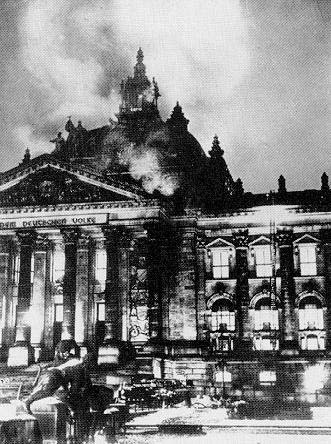
The night of February 27, 1933
loomed dark and gray over the city of Berlin. The Reichstag,
seat of parliamentary government in Germany had been in recess
since December of the preceding year. New elections were
scheduled for March 5th. The great building was quiet and except
for a watchman, empty. At 9:05 that evening, a student passing
by saw a man carrying a burning torch through the windows of the
first floor but did not report it. Ten minutes later smoke was
observed coming from the building and the first fire alarm was
received by the Berlin Fire station. In less than ten minutes
the firemen were on the scene but already flames were breaking
out all over the building. At 9:30 there was a tremendous
explosion and the great central chamber was totally enveloped in
flames. The fire quickly raced out of control despite the
efforts of the fire fighters and soon only the walls of the
gutted building were still standing. Within minutes police
arrested a half naked and seemingly dazed Dutchman, Marinus van
der Lubbe, who was discovered at the scene.
It wasn't long before Chancellor Hitler and Prussian Minister
Göring arrived amid a flurry of reporters and photographers.
Although he had just stepped out of his car, Göring at once
accused the communists of setting the fire. The debate over who
set the fire continues and may never be solved to everyone's
satisfaction. Despite attempts to support the case against van
der Lubbe, who was tried and executed for the crime, a great
deal of evidence collected and analyzed by Walther Hofer of Bern
points in the direction of a SA/SS Sondergruppe headed by
Reinhard Heydrich and an official of the Prussian Ministry of
the Interior, Kurt Dalüge. Less important than the cause of the
fire however was the result. Before the sun rose on the morning
of the 28th, over 4,000 communists and a miscellany of
intellectuals and professional men who had incurred the wrath of
the Nazi Party were arrested. A shaken President Hindenburg, 86
years old, was easily convinced that the nation was on the verge
of a communist revolution, was induced by Hitler to sign an
emergency decree suspending the basic rights of the citizens for
the duration of the emergency. This decree also authorized the
Reich government to assume full powers in any federal state
whose government proved unable to restore public order, ordered
death or imprisonment for a number of crimes including some
newly invented such as resistance to the decree itself. The
decree did not include any provision guaranteeing an arrested
person a quick hearing, access to legal counsel, or redress for
false arrest. Those arrested often found their detention
extended indefinitely without legal proceedings of any kind.
On March 2, Hitler was asked by a corespondent of the Daily
Express whether the suspension of liberties was permanent. He
answered in the negative saying that full rights would be
restored as soon as the Communist danger was over. The reality
was that the decree of February 28th established what would
become the normal order of things under National Socialism -
arrest on suspicion, imprisonment without trial, the horrors of
the concentration camps. This condition would persist until the
end of the Third Reich.
Immediately after its promulgation the decree was turned against
the real and fancied enemies of the Nazi Party. In the last
weeks of the election campaign the Marxist press was silenced.
The Social Democrats found it impossible to campaign effectively
and even respected Center party politicians like former Reich
Chancellor Heinrich Bruning had their meetings broken up by
brownshirted SA thugs. Despite this the Nazi Party fell far
short of the two thirds majority needed to change the
constitution. Hitler now showed his contempt for the rule of law
by turning the decree of February 28th against those states
where significant opposition still existed. Using the argument
that local authorities were unable to maintain order, which was
in the main being disrupted by drunken brownshirts and SS
members, the government replaced the legally constituted
governments of Wurttemburg, Baden, Bremen, Hamburg, Lubeck,
Saxony, Hessen and Bavaria. Soon, with the support of the
Center, Catholic and Bavarian Peoples Parties, the Nazis gained
the passage of the Enabling Act, and Adolf Hitler on the
afternoon of March 23rd, became the supreme dictator of Germany,
free from any restraint from his cabinet or the aged President
Hindenburg and free to mold Germany into the nightmare state of
his darkest dreams.
The events
can be summarized as follows:
-
While it is not
clear whether the Nazis intentionally set the Reichstag fire
in order to create a national crisis, or whether the Nazis
simply were opportunistic, the event was used as justification
for a sharp curtailment in constitutionally guaranteed civil
liberties.
-
The Nazis took
advantage of the additional Federal police powers to suppress
opponents.
-
It is clear that
in other situations, the Nazis did use the tactic of creating
a "law and order" crisis so that they could provide a solution
which further eroded civil liberties and entrenched their
power.
-
The right-wing
Nazis and the left-wing communists were cut from the same
cloth -- the point is not that the far right destroyed civil
rights. Rather, the point is that a democracy can be destroyed
by creating a law-and-order crisis and offering as a
'solution' the abdication of civil liberties and state's
rights to a powerful but unaccountable central authority.
|